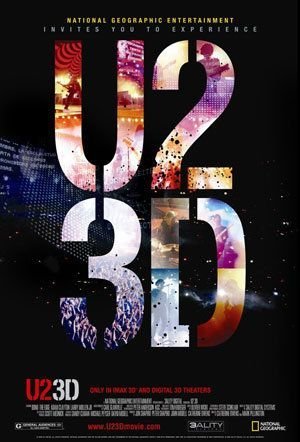
U2 3D raised the bar for concert films to a whole new level. Captured during U2’s Vertigo tour of 2005/’06 in support of their album How to Dismantle an Atomic Bomb, the viewer is immersed in the closest recreation of the concert-going experience through the combination of “the first digital 3-D, multi-camera production of a live-action event” and a 5.1 Surround soundtrack. Even people who aren’t fans of the band will be hard pressed to deny the power that the technology is able to deliver.
As the band opens with “Vertigo,” the film jumps around the stadium, showing the band from different perspectives as well as the audience. No matter where the camera is, everything in the shot is in focus and sounds come from everywhere. As the viewers’ senses are overwhelmed, they could easily lose themselves in the moment to stand up and applaud after a song.
Highlights include Bono nicely filling Luciano Pavarotti’s part on “Miss Sarajevo;” the band performing the rollicking “Love and Peace or Else” on all corners of the stage area; and during “The Fly,” the video graphics are given the 3-D treatment, smacking the viewer right in the face.
To create this film, U2 and their film crew recorded medium-length shots for two days at Azteca Stadium in Mexico City, mid-distance for two days at Morumbi Stadium in Sao Paulo, Brazil, an overhead shot of drummer Larry Mullen during one concert at Estadio Nacional in Santiago, Chile, and mid-to long-distance shots to capture both the band and the fans at River Plate Stadium in Buenos Aires, Argentina. For close-ups, they performed 10 songs without an audience the night before the Argentina shows.
It was Bono’s idea to record the footage in South America where the band would draw enthusiastic crowds because they had not played there in eight years. The audiences’ energy and love for the band combine with the music to create special moments that are greater than the sum of their parts. What’s very impressive is that for the vast majority of these fans, U2’s songs are not sung in their original language, yet they show up in the tens of thousands to dance and sing along. There’s no non-English-speaking band that has that kind of pull in the United States.
Most of the film’s editing is seamless, although there are occasions when the shots don’t match up, such as Bono’s sunglasses during “Sometimes You Can’t Make It On Your Own.” It’s completely understandable when capturing live events, and shows that not every U2 concert is performed exactly the same way, something more bands should emulate.
The Vertigo tour included a recitation of the U.N. Declaration Of Human Rights on the videoscreen, an unfortunate but necessary reminder of reality, which fits in thematically with the band’s songs. It’s this type of preaching during a concert that some fans take issue with because they only want to be entertained. They only want to sing about the troubles in Ireland, the mothers of the disappeared, Martin Luther King, not realizing U2’s songs are meant not only to be heard, but acted upon as well.
The only negatives U2 3D has is that it cuts the concert to 85 minutes and the film doesn’t contain a frequent occurrence at a U2 show of Bono pulling a member out of the audience to dance or sing to a song. Glasses are required.